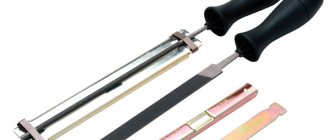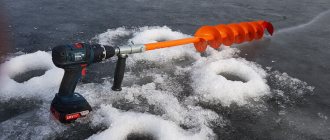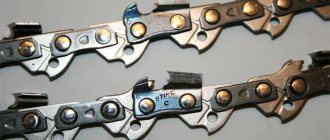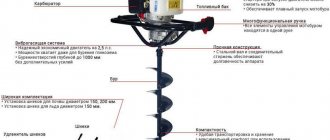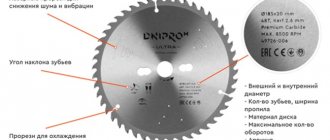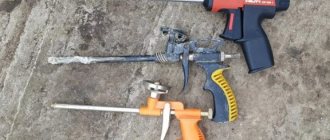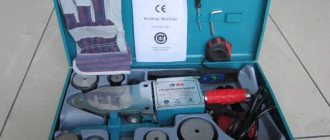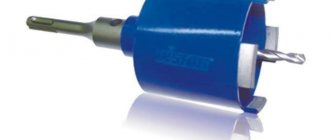Over time, the chainsaw chain loses its sharpness, so its effectiveness decreases. It needs to be replaced, but constantly purchasing new chains is impractical and expensive. Special machines for sharpening chainsaw chains allow you to quickly restore the functionality of the unit. There are many models on the market: from manual mechanical to fully automatic. Knowing which ones are considered the best quality can help you make a great purchase. The device will work for a long time, allowing you to sharpen the chains as needed.
Types of machines for sharpening chainsaw chains
To properly sharpen a saw chain, it is necessary to correctly determine the angle and degree of wear of the product. To do this, special risks are applied to the links. They allow you to determine the most worn parts of the saw material in order to set the required parameters.
There are three types of machines:
- Manual. Professionals who know how to correctly determine the sharpening angle can work with them. Often such models are used at home due to their low price.
Manual machines for sharpening chainsaw chains - Semi-automatic machines with an electric drive are a work table with a tilting sharpening head.
Semi-automatic electric machines - Automatic units involve performing all actions without human intervention. They are used in large industries.
Automatic electrical machines
Important! For household needs, manual (mechanical) and semi-automatic products are most often purchased.
Types of machines, their design and principle of operation
Modern saw chains are a ring-shaped sequence of three types of links (see figure below):
- Leading links. They provide engagement with the driven and driving sprockets, transmitting movement from the engine to the chain. In addition, moving along the guide grooves of the saw bar, they distribute lubricant from the drive sprocket along the entire length of the bar. In the designation of standard sizes of chains, along with its length in inches, an indication of the number of drive links is also used.
- Cutting teeth. Their main working elements are the depth limiter, the end blade and the top blade. The cutting edges of the blades remove short chips like a plane knife, and its thickness is determined by the vertical distance between the planes of the upper blade and the depth stop. The cutting planes of such a tooth always protrude slightly beyond the dimension of the chain, which allows the saw bar to move freely in the cut. The chain alternates between two types of cutting teeth (left and right), which differ in the mirror arrangement of the cutting edges. This solution ensures an even distribution of cutting force on both sides of the direction of chain movement.
- Connecting links. Their purpose corresponds to the name. Designed to connect the first two types of links using rivets.
During operation, the edges of the cutting teeth are periodically corrected with a round file. The need to sharpen a chainsaw chain is usually determined by a number of external signs, including:
- the chain cuts into the wood only when significant force is applied;
- instead of large, brittle shavings, small sawdust falls during the sawing process;
- smoke comes from the cut, burnt marks appear on the wood and sawdust;
- The chainsaw bar moves to the side, vibrates, jumps or kicks back.
In general, sharpening a saw chain includes shaping the end and side blades, as well as establishing the height distance between the leading edge of the cutting tooth and the plane of the depth stop. To determine the correct sharpening angle and degree of wear, chain manufacturers apply special marks to the surface of the teeth. Using this marking, it is easy to determine the most worn tooth in the chain and, based on this, set the required sharpening parameters. This is a very important point, because all the teeth in the chain must have the same size and geometry of the cutting edges, which are set according to the tooth with the smallest size.
If you have certain skills, a saw chain with the same quality can be sharpened either manually using mechanical devices or on a special sharpening machine for electric and chainsaw chains. A variety of equipment, devices and accessories are produced for sharpening chains:
- mechanical devices and mandrels for working with files;
- hand driven tool with appropriate equipment;
- stationary equipment with electric drive and the ability to manually feed the saw chain and tools;
- machines with a full automatic sharpening cycle.
It should be noted that sharpening of solid-tipped chains by hand is impossible and can only be done on machines with abrasive wheels.
Manual machines for sharpening chainsaw chains
When manually sharpening saw chains, round and flat files are used as cutting tools. The cutting surfaces are formed first, and the ratio of the heights of the leading edge of the tooth and the depth stop is formed second. The diameter of the round file must exactly match the size of the curvature of the cutting surface (it is selected according to the tables). Sharpening is carried out at a given angle of inclination in the vertical and horizontal planes (see figure below).
The precision of processing the tooth surface is tenths of a millimeter, therefore, to fix the file, various devices and hand-held machines are used, which are attached to the saw bar and ensure precise movement of the file at the required angles and to the required depth. In such devices, the file moves along guides, which are adjusted using a regulator at a given angle. The sharpening depth is set according to the size of the most worn tooth and is maintained for the entire chain processing cycle. When grinding down the depth stop, the round file is replaced with a flat one. The most common hand-held machines of this type resemble a bow saw in appearance (see photo below).
VIEW Saw chain sharpening on AliExpress →
Some inconvenience of machines with mounting on a bar is that with each subsequent movement of the tooth it is necessary to turn the chain brake on and off. Therefore, desktop devices with the same working part are produced, in which the chain moves along special guides using a lever with a lock. Although manual sharpening machines from different manufacturers have some design differences, the operating principle and design of most of them are approximately the same. Against this background, the original design of the Timberline chain sharpening machine attracts attention (see photo below).
VIEW Saw chain sharpening on AliExpress →
Electric semi-automatic sharpening machines
The main operating components of semi-automatic machines with an electric drive used for sharpening saw chains are a work table for securing the saw chain and a sharpening head tilted down with an abrasive wheel. In general, the process of sharpening a chain on such a machine consists of the following steps:
- Placing the chain on the workbench guides.
- Rotate the work table to the desired sharpening angle on a graduated scale.
- Fixing the chain with a stopper.
- Setting the required tooth groove depth on the grinding head.
- Turn on the electric motor and lower the sharpening head by the handle to the tooth surface until the specified depth is reached.
- Retract the sharpening head to the upper position and turn off the power supply.
- Unfasten the chain, move it to the next tooth and repeat the turning operation.
After finishing the processing of the teeth of one side of the chain, they are checked with a gauge. After this, the chain is turned over to the other side, and the sharpening operation is repeated with the same parameters. There are machines with additional mechanization means, which mainly facilitate and speed up the processes of tensioning, advancing and fixing the chain, as well as synchronizing the operation of the chain and grinding head mechanisms.
Fully automatic machines
On automatic machines for sharpening saw chains, the entire cycle of operations is performed without human intervention.
Such equipment has a purely professional purpose and is used at large logging enterprises or in repair shops with large volumes of sharpening work. The video below demonstrates the operation of a sharpening machine from the famous German company Franzen. Installing the chain and setting sharpening parameters is done manually. The movement of the working parts of the machine is carried out by means of hydraulic drives controlled by the controller. The chain is sharpened simultaneously by two heads: the top one is for the cutting tooth, the side one is for the cutting depth limiter.
Please note that the upper head, turning in both directions, alternately processes the left and right teeth, i.e., the entire chain sharpening is performed in one pass.
Operating principle
Regardless of the type of machine, the operating principle is similar:
- Placing the chain on the work surface.
- Rotate the sharpening material at the desired angle.
- Fixing the chain so that it does not move during operation.
- Indication of the required sharpening depth.
- Place the sharpening head on the chainsaw chain and sharpen to the desired depth. After this, the sharpening material must be removed.
- Releasing the chain to place it on the other side.
- Repeat the above operations.
Fully automatic units perform all actions independently.
Video - How to properly sharpen a saw chain on an electric machine
Grinding machine device
Equipment for sharpening chains is a structure somewhat reminiscent of an assembly cutting machine, only instead of a cutting disc it has a grinding disc installed on it. Most often, a sharpening wheel with a thickness of up to 3.5 mm is used for sharpening a chain. The circle is mounted on a frame with a hanging head and a special mounting vice. The working part of the chainsaw is fixed on the machine using rotary clamps, and the disk itself is alternately transferred to each of the links. Any sharpening apparatus requires preliminary adjustment, and the angle between the chain and the grinding disk is determined depending on the pitch of the links.
Before you start processing the chain, be sure to read the instructions - it contains not only the characteristics, but also practical advice on setting up the equipment, as well as the main points of proper operation of the machine. You can make a sharpening machine yourself by converting a mounting saw, but if you are capable of such a technique, then do not waste your time and start setting it up right now. Using a grinding machine allows you not only to sharpen the teeth, but also to straighten the chain links.
Machine tools are divided into two categories: manual and automatic. Automatic units have better efficiency indicators than manual ones, but they are also much more expensive. They have several criteria by which selection must be made: power, weight, noise level and spindle speed. Such devices have additional accessories designed to expand functionality and increase sharpening speed. The cost of an automatic machine consists of the totality of all parameters.
The biggest advantage of such a unit is the complete automation of sharpening. You just need to install the chain in a vice at the desired angle, and the unit will do all the work itself. Such devices, however, have a serious drawback - the chain elements wear out faster and require replacement after several sharpening cycles.
Manual equipment, in turn, is divided into 2 types: mobile and stationary. Mobile machines are small in size and suitable only for domestic needs, but stationary machines are most often installed in workshops. The spindle rotation speed in them is not the main characteristic, since it depends on the degree of effort applied. On average, a manual machine will cost 500-5000 rubles, and the low sharpening speed is compensated by its highest quality, as well as the absence of the need to connect the equipment to the network. If you have never sharpened a chain by hand, most likely you will not be able to do this the first time, since hand sharpening requires certain dexterity and skills.
When sharpening by hand, it is difficult to process all the links evenly; you have to rely on your eye and intuition. Also, when sharpening teeth by hand, it is necessary to cool the chain with compressed air, and at the end of the process, immerse the entire chain in machine oil. If you already have sufficient experience in sharpening chains, you can use a file instead of a machine, but this process is even more labor-intensive and complicated than sharpening on special equipment.
Which is the best machine for sharpening chainsaw chains?
There are several principles that allow you to choose the optimal model:
- spindle speed and grinding wheel diameter. It is important that the maximum linear speed is 30-35 m/s;
- unit power. The optimal value starts from 100 W. Models with this parameter over 400 W are industrial;
- equipment. Not all devices come with a screen protector;
- the presence of additional functions, including tensioning the chain, moving it to a new position, quick clamping, etc.
These are the main parameters that allow you to choose the optimal machine. By choosing from the above models, you can purchase a device that will work for a long time. However, new devices are constantly appearing on the market, which may also turn out to be quite good. Thus, before purchasing, you should definitely look at the offers on the market and read reviews.
Video - Which chain sharpening machine to choose
General criteria for selecting sharpening machines
Disk rotation speed
The speed of rotation of the disk largely determines the speed of processing the material, that is, sharpening the chain. The higher the speed, the faster the chain sharpens. However, there is also a downside: since with high-speed machines the metal is removed from the tooth faster with less exposure time, then with inept handling you can quickly grind down the tooth and ruin the chain if you suddenly set the sharpening angle incorrectly.
Devices with a spindle speed of 2000 to 3000 rpm are considered low-speed, so they are worth buying only if you do not plan to sharpen chains frequently. And for constant sharpening, for example, in forestry or to make money sharpening tools, it is better to buy a device with a wheel rotation speed of 3000 - 7500 rpm. For example, you can take an inexpensive Kalibr-EZS 220 with a speed of 7500 rpm.
Power
This parameter is not key when choosing a sharpening machine for your home. For most machines, the power ranges from 70 to 250 W, and it is quite enough for work. Only a few have engine power that can reach 600 W. Which sharpening machine is better: with a power of 200 or 600 W? For the most part, power affects how the machine will cope with loads, that is, the number of chains sharpened in a short period of time. So, if you sharpen one chain per day, then there is absolutely no point in chasing power. But for constant sharpening, for example, if you earn money from this while sitting in a workshop on the market, a powerful device would be preferable. Let's say from experience that finding a powerful machine at an adequate price is quite problematic.
Grinding wheel dimensions
The original wheel is always included with the saw chain sharpening machine. The thickness of the circles can be from 1.5 to 5 mm - it is not advisable to use thicker ones due to the small pitch of the chain. The thinner the disc, the easier it is to work with, but the wear and tear is much higher. Although in this case it is worth noting that with infrequent use, wear is not particularly noticeable.
- Purchase
How to choose a sandblasting gun for a compressor?
The disk size for such machines is about 100 - 145 mm. This indicator is worth paying attention to when purchasing spare disks. Also pay attention to the diameter of the seat. In some devices it can be 10 mm, and in some 22.3 mm. You can no longer fit circles with a smaller hole on devices with a large mounting socket. But on the contrary, you can use a device such as a dial nut, as is the case with circular saws.
Portable or stationary
The vast majority of the best sharpening machines are stationary, and in order to operate they must first be screwed to the workbench. For regular chain sharpening in a home workshop, a stationary machine is an ideal option.
However, there are also portable machines (not a hand file) that can be used to sharpen chains in the field. For example, while collecting firewood in the forest, you caught a wire with a chain and it became blunt. With this mini machine you can quickly sharpen a chain without returning home. It operates on 12 V, so it can be connected to a regular car battery. True, the quality of sharpening will depend on the professionalism of the master, so if you are planning to buy just such a machine, be prepared to practice a lot. An inexpensive one you can buy is Champion C2002 .
Extra options
For some, additional functions that some models are equipped with may be decisive in choosing a household disk machine:
- Backlight . The backlight really helps out when working in a poorly lit garage, or when someone simply has poor eyesight. It gives better visualization of the chain link being sharpened. Only a few models are equipped with backlighting, although this is a really useful thing.
- Quick access to carbon brushes . The carbon brushes of the motor wear out from time to time and fail. In some devices, to get to them you will have to spin up almost the entire engine. And there are devices in which there is a special hatch on the body, by opening which you can easily remove the carbon brushes without disassembling the entire device and contacting a service center.
Voting for the best chainsaw chain sharpening machine
Which chainsaw chain sharpening machine would you choose or recommend?
QPT ZS-325
2.86 % ( 1 )
STIHL USG
34.29 % ( 12 )
OREGON 519789
14.29 % ( 5 )
OREGON 620-230
2.86 % ( 1 )
OREGON 220 590181
8.57 % ( 3 )
CALIBER EZS-220
8.57 % ( 3 )
REZER EG85-CN
8.57 % ( 3 )
VORTEX SZTS-200
11.43 % ( 4 )
Proton TE-130
5.71 % ( 2 )
DDE GT010B (647-697)
0.00 % ( 0 )
OREGON 23736A
0.00 % ( 0 )
REZER HSB-303
0.00 % ( 0 )
How to make it yourself
In this paragraph, we’ll look at how to create your own machine for sharpening chainsaw chains with your own hands at home.
Materials:
- Engine.
- Grinding wheel.
- Grinding wheel fasteners.
- Sheet steel.
- Switch.
- Wiring is insulated.
- Construction corner.
- Various small items (bolts, nuts, screws).
- Engine. Motors from old washing machines are actively used in sharpening machines. When searching for a motor, it is important to take into account the power; it must be compared with the diameter of the grinding wheel. The larger the diameter of the circle, the greater the torque the motor shaft must develop, otherwise the circle may stop under load. In purchased versions of the machines, a 250 W motor rotates the circle by 200 mm, these figures should be approximately adhered to. Of course, it is better for the machine to have a power reserve, but do not forget that the grinding wheel will decrease in diameter as it wears out.
- Base and circle. We prepare a reliable base for the sharpener (the simplest frame is made from a corner and sheet steel). We make reliable fasteners for the motor; it needs to be screwed with bolts and nuts. Grovers and nuts with plastic locking rings will not be superfluous. Many people immediately install a grinding wheel on the motor shaft; here they need to select a plus and make bushings depending on the diameter of the wheel. The circle is usually clamped with large washers on both sides; it would be a good idea to place cardboard spacers under the washers.
- Protection. Next, you need to create a special protective frame, the installation of which takes no more than twenty minutes, but during the process of sharpening something you will not be bombarded with various consumables. In this case, the protective shield is welded into the frame where necessary, secured with ordinary metal rods, pipes, and brackets.
- Emphasis. To make it comfortable and safe to work on the machine, we put emphasis on it. The emphasis must be adjusted in at least two positions - vertically and horizontally. It will move towards the grinding wheel as it wears out, and will be used in other equally important stages of work. We assemble the stop from a corner, plates and sheet steel, and we find the drawings on the Internet or invent them ourselves, since the mechanism is simple. You can also weld pipes to the nuts, and insert steel rods into the pipes as the main handles - it will be much more convenient to use the device.
- Shield cover. We are making a cover for the shield; it should be removable so that the circles can be replaced as needed. We cut out the cover itself from sheet steel and drill holes in it. We weld bolts or threaded rods to the shield itself; as a result, the cover will be secured with nuts. It would be a good idea to make a window at the bottom of the shield through which excess debris will pour out.
- Final touches. At the end, you need to make a sleeve with wiring, install a reliable switch and paint the machine in your favorite color (this will make the work process much more interesting). The homemade product looks great and works flawlessly. There is another axis on the back of the motor; you can put a brush or polishing wheel here. This completes the project, I hope you liked the homemade product and found something interesting. Good luck and creative inspiration if you decide to do this again. Also, think about the cost of such a device and find out how much a machine for sharpening chainsaw chains costs directly from the store.
You may be interested in: Choosing a lawn mower for the home: rating of the best gasoline and electric ones, reviews
Expert advice
Sharpening chainsaw chains has its own characteristics. In accordance with the technology of work, the teeth should not be allowed to overheat and should not be cooled with water. This leads to the destruction of the metal from which the chain is made. The material must never be cooled with water.
Expert opinion
Kuznetsov Vasily Stepanovich
Chains can be sharpened only with abrasive discs that have a perfectly flat surface. When using wheels with a coarse-grained surface, the cutting edges must be ground.

